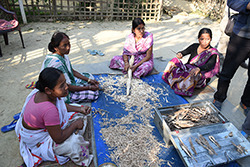Better management of agarwood
20 February 2015

Agarwood chip production by a local community industry in Upper Assam, India. Photo: Assam Agarwood Association
Agarwood is a resinous wood that forms in species of Aquilaria, Gyrinops and several other genera native to Southeast Asia. These species produce a dark aromatic resin in response to infection by a type of fungal mould. This resin-embedded “agarwood” is highly valued for its fragrance and is used to produce incense, perfumes and various other products.
The report covers topics such as (click on the links to download relevant presentations):
- formulation of non-detriment findings (NDF) for agarwood
- the role of plantations in balancing harvests from natural forests
- management and silviculture of natural agarwood
- plantation grown agarwood: potential resources and management
- managing agarwood-producing species in natural forests and in plantations
- current agarwood trade trends
- country reports from Bangladesh, Bhutan, Cambodia, China, India, Indonesia, Malaysia, Myanmar, Nepal, Thailand and Vietnam
The report also contains draft decisions to be considered at the 22nd meeting of the CITES Plants Committee to be held in October 2015 for possible adoption at the 17th Conference of the Parties in 2016.
The workshop was co-funded by CITES and ITTO, the latter through the ITTO–CITES Program. It was hosted by India’s Ministry of Environment, Forests and Climate Change (Wildlife Crime Control Bureau).
For more information on ITTO and the ITTO-CITES Program, visit www.itto.int.
For more information on CITES, visit www.cites.org.